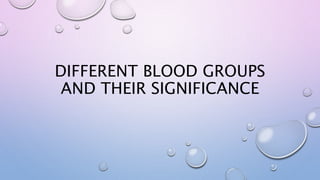
Different blood groups and their significance
- 1. DIFFERENT BLOOD GROUPS AND THEIR SIGNIFICANCE
- 2. HISTORY • KARL LANDSTEINER DISCOVERED ABO BLOOD GROUP SYSTEM IN 1901 • DISCOVERED RH FACTOR IN 1930 ALONG WITH ALEXANDER S. WIENER
- 3. LANDSTEINERS RULE • If an antigen /agglutinogen is present on the red cell membrane of an individual, the corresponding antibody/agglutinin will be absent in the plasma. • If an antigen / agglutinogen is absent on the red cell membrane of an individual, the corresponding antibody / agglutinin will be present in the plasma.
- 4. • MAJOR ABO RH (RHESUS) • MINOR LEWIS DUFFY KIDD KELL LUTHERAN
- 5. ABO BLOOD GROUPING • BLOOD GROUP A If you belong to the blood group A, you have A antigens on the surface of your RBCs and B antibodies in your blood plasma. • BLOOD GROUP B If you belong to the blood group B, you have B antigens on the surface your RBCs and A antibodies in your blood plasma.
- 6. BLOOD GROUP AB If you belong to the blood group AB, you have both A and B antigens On the surface of your RBCs and no A or B antibodies at all in your blood plasma. BLOOD GROUP O If you belong to the blood group O (null), You have neither A or B antigens on the Surface of your RBCs but you have both A and B antibodies in your blood plasma.
- 8. PRINCIPLE OF BLOOD GROUPING • Blood grouping is done on the basis of agglutination. Agglutination means the collection of separate particles like RBCs into clumps or masses. • Agglutination occurs if an antigen is mixed with its corresponding antibody which is called isoagglutinin, i.e. Occurs when A antigen is mixed with anti-A or when B antigen is mixed with anti-B. • Almost all normal healthy individuals above 3-6 months of age have “ naturally occurring antibodys” to the ABO antigens that they lack. These antibodys termed naturally occurring because they were thought to arise without antigenic stimulation
- 10. FORMATION OF H ANTIGEN • The H antigen is the foundation upon which A and B antigens are built • A and B genes code for enzymes that add a sugar to the H antigen • Immunodominant sugars are present at the terminal ends of the chains and confer the ABO antigen.
- 11. FORMATION OF A ANTIGEN FORMATION OF B ANTIGEN
- 12. BOMBAY BLOOD GROUP • RBCs with no H, A, or B antigen (patient types as O) • Bombay RBCs are NOT agglutinated with anti- A, anti-B, or anti-H (no antigens present)
- 13. • Bombay serum has strong anti-A, anti-B and anti-H, agglutinating all ABO blood groups • What blood group would you use to transfuse this patient?? • ANOTHER BOMBAY • Group O RBCs cannot be given because they still have the H antigen you have to transfuse the patient with blood that contains No H antigen
- 14. Rh GROUPING • It is the most important blood group system after ABO. • All Rh antigens are controlled by 2 genes – RHD gene– determines expression of D , RHCE – encodes for C,c and E,e. • RhD is a strong antigen (immunogenic) and other antigen are less antigenic than D and are of less clinical significance. • Therefore , in practice Rh negative and Rh positive depends on presence of D antigen on the surface of red cells which is detected by strong anti-D serum. Occasionally, anti – C,E,c,e may develop in case of pregnancy or transfusion.
- 15. • Unlike ABO system there is no naturally occuring antibodies against Rh antigens in Rh negative individuals. Immune ANTIBODYS develop against Rh antigen after exposure to it following transfusion or pregnancy. • It can be detected by enzyme treatment or coombs test(antiglobulin test) • SIGNIFICANCE: Rh incompatibility results in haemolytic tranfusion reaction. Haemolytic disease of newborn.
- 16. IMPORTANCE OF BLOOD GROUPING AND RH TYPING • IN BLOOD TRANSFUSION • HAEMOLYTIC DISEASE OF NEWBORN. • PATERNITY DISPUTE • MEDICOLEGAL ISSUES • IMMUNOLOGY,GENETICS • SUSCEPTIBILITY TO VARIOUS DISEASES (BLOOD GROUP O – PEPTIC ULCER, BLOOD GROUP A – GASTRIC ULCER)
- 17. MINOR BLOOD GROUPS AND SIGNIFICANCE 1.Duffy blood group- lack glycoprotein DARC, which is receptor for plasmodium vivax. So this blood group patients are not susceptible to malaria. 2. Kell blood group- very immunogenic . increased hemolytic disease of new born. 3.Kidd blood group- increased hemolytic transfusion reaction.
- 18. UNIVERSAL DONOR AND RECIPIENT UNIVERSAL DONOR GROUP O NEITHER A OR B ANTIGENS UNIVERSAL RECEIPIENT GROUP AB PATIENT HAS NO ANTI A/ANTI B PRESENT. CANNOT LYSE ANY TRANSFUSED CELL
